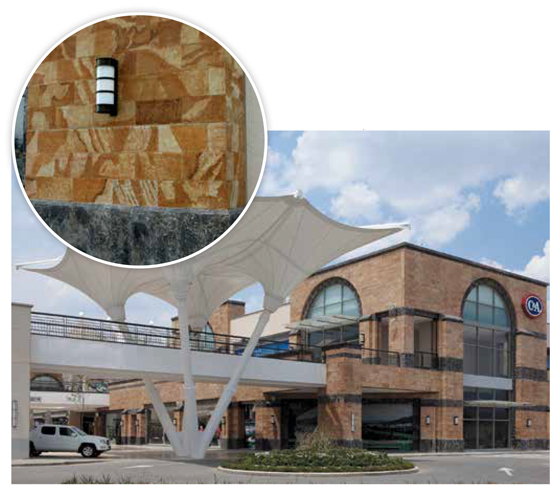High-Performance Aesthetics in Precast Concrete
Precast Concrete Sees the World in Full Color
Precast concrete comes in an almost endless array of colors. Color can be created by natural materials, such as aggregates like stone and sand, or via cements and colored pigments, or from a combination of both, depending on the finishes selected. To achieve optimum results, it is important to have a basic understanding of these ingredients, and to use high-quality, consistent materials and processes.
The color of concrete is composed of the paste (cement and water), matrix (paste and sand), and stone (coarse aggregate). Which components contribute most, or dominate, the color contribution depends on the finish selected and degree of exposure. The term “exposure” refers to the matrix and coarse aggregate.
To help differentiate the primary contributing material to color, we can place finishes into two basic groups. Both of these are different in terms of color, finish, reproducibility, and longevity. First is paste-dominant color, wherein the primary contributor to color is the paste. This color application is typically found in zero to light exposure finishes. Paste is made up of cement and water, which, when combined, create a chemical reaction called hydration. It should be noted that pigments that are used to sometimes tint the paste portion of the concrete are inert.
Aggregate-dominant color, where aggregate is the primary contributor to color, is typically seen in medium to deep exposure finishes. The term exposure refers to the degree to which the aggregate is part of the finish. “None” would denote a color that is paste only, or skin. Light exposures predominantly feature sand and paste. Medium exposures typically have half-and-half mix, where half of the visible concrete is aggregate. Heavy, or deep, exposures refer to coarse aggregate being mostly visible.
In form finishes and light exposures, most of the color is derived from the paste and matrix, whereas, with deeper exposures, the coarse aggregate becomes the primary contributor to color.
Paste is the binder in concrete, resulting from the mixing of the cement and water, and can be colored by a variety of pigments. During the chemical reaction of hydration, slight alterations in the variables can produce different results. For example, if more water is added to a concrete mix, typically a lighter color of paste will result. Furthermore, paste-dominant finishes may be more susceptible to color variation and changes in color over time, especially depending on the environment a project is located in.
When using paste, there are several important quality-assurance measures of which to be aware. Fluctuations in the water-to-cementitious ratio can result in panel-to-panel color variation. More curing will typically darken the final finish. High porosity can result in staining as well as absorb runoff water, so make sure the concrete has a low absorption rate. Paste-dominant color is also susceptible to weathering and acid rain, which may alter the color with time.
Aggregates Provide Great Color Stability. Aggregate-dominant color, the second major category of color, derives its hue from aggregate mixed into the concrete. Aggregate-dominant finishes may include coarse or fine aggregates, such as silica, limestone, granite, marbles, and quartz. Aggregate colors range from whites and pastels to red, black, and green. Natural gravels provide a wide range of rich, warm earth colors as well as shades of gray.
Color from aggregates is fairly consistent over time, and curing does not affect color. Typically, aggregate-color-dominant concrete is very durable and resistant to weathering and staining, depending on hardness. There is also less panel-to-panel variation if properly blended. Moisture does not alter the color of most aggregates. However, there are some design considerations when choosing an aggregate color. Soft aggregates, like silica, may wear over time. Round aggregates, like river gravel, have less bonding ability and less surface area, so they retain less dirt and pollution, and are more easily crafted to a consistent finish. Angular aggregate, like crushed granite, has more surface area, which allows for a better bond but more dirt retention. The irregular shape of this aggregate type makes it more difficult to develop a consistent profile between panels on returns.
Using the exceptional flexibility afforded by both paste- and aggregate-dominant color, architectural precast concrete can be cast in almost any color, form, or texture to meet the aesthetic and functional requirements of the designer in an economical manner. Complementary combinations of color and texture can aesthetically improve any project.

Photo courtesy of Karen Weber © FOTOSENCONCRETO.COM
This large outdoor mall in Mexico used a precast concrete enclosure system that combined pigments, formliners, acid etching, and chiseling techniques to emulate the black and orange natural stone. Precast concrete reduced the overall time and cost of the project relative to using the natural stone.









